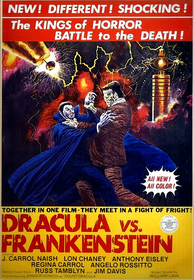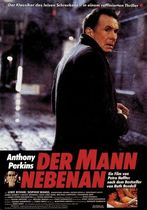Our editor-in-chief Nate Yapp is proud to have contributed to the new book Hidden Horror: A Celebration of 101 Underrated and Overlooked Fright Flicks, edited by Aaron Christensen. Another contributors include Anthony Timpone, B.J. Colangelo, Dave Alexander, Classic-Horror.com's own Robert C. Ring and John W. Bowen. Pick up a copy today from Amazon.com!
Dracula vs. Frankenstein (1971)
What a glorious mish-mash this is! Dracula vs. Frankenstein began life as Satan's Bloody Freaks, a standard mad science flick featuring J. Carrol Naish as a mad scientist and Lon Chaney, Jr as his faithful servant. However, the completed film was not to the liking of producer/co-writer Samuel M. Sherman, and the movie went back into production to add new scenes with Dracula and the Frankenstein Monster. However, the new ending didn't have the "punch" that Sherman wanted, so a new one was shot with a different actor in the Monster's makeup.1 As a result of its wacky production history and somewhat shabby production values, Al Adamson's Dracula vs. Frankenstein is one of the great "bad" movies of all time.
In Venice Beach, CA, there's a sideshow exhibit called the "Creature Emporium" run by the wheelchair-bound Dr. Duryea (Naish). If the thrill-seekers knew what went on in Duryea's secret lab, though, they'd tear up their tickets and run. The mad scientist is developing a serum made from the blood of exceptionally traumatized women. His specimens are collected by his hulking, mute manservant Groton (Lon Chaney, Jr.), who clutches a puppy to his chest when he's not wielding an ax. One night, Duryea is visited by Count Dracula (Zandor Vorkov), who knows that the doctor is really the last of the Frankenstein line. Together, they resurrect the original Frankenstein Monster. Dracula wants Duryea's serum for his own purposes, but all evil plots are threatened when a nosy Vegas singer, Judith (Regina Carrol, Adamson's wife), comes looking for her missing sister. Can Duryea perfect his serum? Will it make Dracula immortal-er? Could somebody tell Groton about the rabbits, George?
The attempts to join the new Dracula and Frankenstein
footage to Satan's Bloody Freaks are equal parts clever and
inane. Adamson and Sherman were assisted somewhat in their efforts by
the fact that the original movie is extremely dark, with pure black
backgrounding scenes in Duryea's exhibit. Thus it became easy to
insert new shots of Dracula stalking Judith and her friends as they
investigate the Creature Emporium without creating any mismatches in
the footage. However, a new scene with Dracula confronting Duryea
(Naish was brought back for a single day of shooting) is rife with
inane exposition that desperately tries to make a semi-logical
connection between the old footage and the new plot. Dracula
essentially tells Duryea his own (very convoluted) life story, while
the doctor solemnly nods and occasionally restates information.
Amusingly, despite the reams and reams of blather and exposition,
Dracula never gives a particularly convincing explanation for why
he's brought the Frankenstein Monster into this mess. I'm sure it
wasn't, "So I can fight him at the end of the movie."
More
extreme inconsistencies show up with the new ending, which was shot
with absolutely no budget in upstate New York.2 Actor Anthony Eisley, who plays Judith's hippie-beatnik love interest
Mike Howard, was unavailable, so a bit was shot where Dracula uses
his mystical ring to fire a bolt of energy at Mike (director Adamson
standing in for Eisley), who promptly combusts, messily removing him
from the movie. Dracula's makeup, which up until Mike's assassination
had actually been impressively subtle, suddenly switches to a garish
pasty white with black, raccoon-like rings around the eyes and a set
of improbably large fangs jutting out of the mouth. Surprisingly, the
change in actors for the Frankenstein Monster is barely noticeable.
The immobilizing facial makeup is the same, although he has grown an
impressive set of claws in a very short span.
Dracula vs. Frankenstein marks the screen debut of Zandor Vorkov (really Roger Engel, stock broker). Adamson chose him for Dracula over Sherman's recommendation of John Carradine. Vorkov, whose nom de screen was chosen for him by Forrest J Ackerman3, is not the worst Dracula ever, although he's hardly the best. In his quiet moments, he does exude some menace, mostly by remaining very still. Unfortunately, he spends most of his scenes on a non-stop ramble and it's here where it becomes apparent that Vorkov just isn't comfortable with dialogue. His posture is a little too stiff, his walk just slightly unsteady. You can almost see the thoughts zipping through his brain: "Okay, how would Dracula say this next line? What is the next line? Dammit, I bet Lugosi never worried about this stuff." One wonders if Vorkov knew that Adamson would go on to add an echo effect to his every word, making this Dracula a memorable one, although not for the right reasons.
While Vorkov made his debut, two of his co-stars turned in the final performances of their career, sad swan songs for actors who deserved better. Naish, at least, maintains a modicum of dignity, although he's forced to speak some unfortunate dialogue ("All illusions look real or they wouldn't be illusions, would they?"). It's not a great performance, not with that accent that vacillates between German and Brooklyn, but it's a serviceable one. Chaney, alas, is another story entirely. His body bloated from years of alcoholism and his voice silenced by the ravages of throat cancer, Chaney is a pathetic figure who lumbers through the movie, desperation etched into the lines of his face. His character, Groton, spends much of the film in a child-like state, so Chaney mugs wildly and pets a puppy, a shadow of his Lenny from Of Mice and Men. Sherman recalled that one day after shooting, he was driving some of the actors back to the hotel and they decided to stop off for a drink. Chaney, already quite drunk, opted to stay in the car because he didn't want his fans to see him in that state.4 And we don't enjoy seeing you like that, Lon. It breaks my heart a little.
In their screenplay, Sherman and co-writer William Pugsley create a world that resembles our own on the surface, but the people don't quite act within our understanding of human nature. For instance, after Judith has a freakout in a local hippie club (thanks to a drugged coffee), she wakes up in a strange bed in a strange house, with a strange man watching over her. Rather than treat the whole situation with suspicion and panic, she accepts the explanation provided by the man (Mike Howard) without question and thanks him for his help. When Judith and Mike receive the news of a homicide/kidnapping, Mike coolly apologizes, "It's not usually this gory on the premises." Sgt. Martin shoots at Groton when the henchman is looking particularly cuddly and non-threatening, presumably because the police have a copy of the script and know that Groton's really a bad guy. My favorite moment of "um, okay..." comes from Mike's friend Strange (Without Warning director Greydon Clark). Emerging from Duryea's Creature Emporium, the hippie discovers a tire and declares, "Oh, it has meaning! Everything has meaning!" The meaning he infers is that he can use the tire to play a game of Fetch with his girlfriend. Yeah, it's kind of brilliant in an accidental way.
You could start a drinking game based on the number of times actors have a scene together but never share a shot. While this might seem to be a symptom of the reshoots, it's actually evident in the original Satan's Bloody Freaks footage as well. Duryea has most of his conversations with Groton from across the very large room. In all likelihood, the actors were shot at separate times so that a low-budget outfit like Independent-International wouldn't have to pay both Naish and Chaney at the same time. This would also explain why characters like biker Rico (Russ Tamblyn) and Police Sgt. Martin (Jim Davis) show up at random intervals, despite having almost nothing to do with the main plot -- they add semi-recognizable names to the cast (both Tamblyn and Davis are credited as "Special Guest Stars") without requiring them to share scenes with the top-billed Naish and Chaney.5
Amidst all this unintentional wackiness, though, there are moments where Dracula vs. Frankenstein really shines. The opening is well-directed and edited, as Dracula, under the cloak of night, unearths the Frankenstein Monster from his grave. This atmospheric sequence flows with spookiness, a feeling which is never replicated later. The climactic title fight doesn't disappoint (despite Dracula's insistence on talking throughout), as vampire and creature duke it out deep in the forest, their shaded forms melding into the background and out again. The struggle ends more like Holyfield-Tyson than Foreman-Ali, which is appropriate, all things considered. To give visual oomph to Dracula's exposure to the sun, Adamson and Sherman came up with a solution both effective and ingeniously low-budget -- they smeared mud into his makeup, giving his skin the appearance of charring and crumbling.
More important than anything, however, is that Dracula vs. Frankenstein is damned entertaining. There's hardly a boring minute in the whole hour-and-a-half, something that can't be said of other classically bad horror movies like Manos: The Hands of Fate and The Creeping Terror. I've watched Dracula vs. Frankenstein at least three times in the course of reviewing it and each time, I've found new weirdness and amusing bits of unintentional hilarity. Bad filmmaking can equal great fun, if you enter into it with open eyes and a sarcastic mind. Dracula vs. Frankenstein is proof enough of that.
- 1. Ray, Fred Olen. The new poverty row : independent filmmakers as distributors. Jefferson, N.C.: McFarland, 1991.
- 2. The rest of the movie had been filmed in California.
- 3. Ray.
- 4. Ray.
- 5. Tamblyn does eventually apear in one shot with Chaney, but only briefly and his character is dead at the time.









Nice to see you giving DvF a
Nice to see you giving DvF a nod here. This film was our contribution to Cinema Styles' "Spirit of Ed Wood" blogathon but we are STILL toiling over its riches.
Even though it has been reviewed by at least 4 bloggers in the past 2 months or so (including yourself), we can't believe no one else sees the intensely complex thematic masterpiece that the Maciste Brothers do! We know you guys are drawn to watch and write about it -- but we think the sheer ambition of it's construction is something that WILL eventually rear its pointed little head at y'all. That eventually will probably be sometime by the end of this week as we proudly deconstruct this film once and for all.
So, nice post -- but NOT a bad movie.
Part of the reason I put
Part of the reason I put "bad" in quotes is that any film as entertaining as Dracula vs. Frankenstein must be, in some way, good. Truly bad films are boring films. Films like The Cell 2 and the original Prom Night.
"He went for a little walk! You should have seen his face!"
You have persuaded me to
You have persuaded me to purchase this film. I adore you so.
Chris Gaskey
http://chrisgaskey.tumblr.com
http://www.skyemag.com
http://www.facebook.com/chrisgaskey
http://www.twitter.com/chrisgaskey